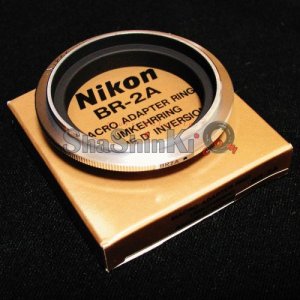- Joined
- Apr 30, 2005
- Messages
- 34,339
This is a PSA thread for people with a SLR camera, film or digital, who don't have a macro lens but want to do close up work.
Macro lenses for SLRs are expensive.
There is an affordable way to get pretty good high magnification results with a standard lens by just turning it backwards.
You must buy an adaptor that screws into the filter side of your lens and has the compatible mount for your camera body.
The adaptors are around $40, much cheaper real macro lenses which run into hundreds of dollars, one is $1800.
The quality will not be as good as a true macro lens but I hear it's pretty good.
I have not tried this technique since I have a macro lens (actually three).
The adaptor ring below is the Nikon BR-2A, which is for lenses with a 52mm filter size.
Obviously if your filter size is different you must get a different adaptor.
Note, you lose auto focus and have to compose with the lens' aperture fully open, then stop it down for the exposure.
It may take a few shots to get the exposure correct.
But hey, want do you want for $40?
I'm not positve how well it works with today's zoom lenses that usually come with DSLRs but you can pick up a used 50mm f1.4 nikkor lens VERY cheap (probably under $50) for this purpose.
Nikon started making this lens 60 years ago so just buy an old one with no autofocus since that won't work backwards anyway.
Zillions of Nikons came new with this lens and owners sold them because they wanted other fancier lenses instead.

Macro lenses for SLRs are expensive.
There is an affordable way to get pretty good high magnification results with a standard lens by just turning it backwards.
You must buy an adaptor that screws into the filter side of your lens and has the compatible mount for your camera body.
The adaptors are around $40, much cheaper real macro lenses which run into hundreds of dollars, one is $1800.
The quality will not be as good as a true macro lens but I hear it's pretty good.
I have not tried this technique since I have a macro lens (actually three).
The adaptor ring below is the Nikon BR-2A, which is for lenses with a 52mm filter size.
Obviously if your filter size is different you must get a different adaptor.
Note, you lose auto focus and have to compose with the lens' aperture fully open, then stop it down for the exposure.
It may take a few shots to get the exposure correct.
But hey, want do you want for $40?
I'm not positve how well it works with today's zoom lenses that usually come with DSLRs but you can pick up a used 50mm f1.4 nikkor lens VERY cheap (probably under $50) for this purpose.
Nikon started making this lens 60 years ago so just buy an old one with no autofocus since that won't work backwards anyway.
Zillions of Nikons came new with this lens and owners sold them because they wanted other fancier lenses instead.








300x240.png)